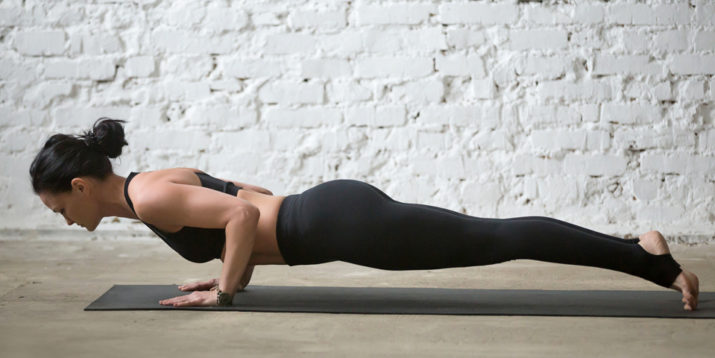How to Do Chaturanga Dandasana Yoga Pose With Perfect Form (Video)

For beginner yogis, one of the most challenging poses is chaturanga dandasana, or low plank pose. Although it’s a foundational yoga pose for arm balances and is one of the main poses in the Sun Salutations, it requires enough arm strength to slowly lower your body down towards the floor from plank pose. And since the name chaturanga dandasanatranslates to “four-limbed staff pose,” that gives the instruction to remain as straight as a staff while doing so, which can make this pose even more difficult.
In addition to demanding a lot of arm strength, there is also a tendency to shrug up into the shoulders or tilt the pelvis, which makes this transition from plank quite elusive. Follow the instructions below to learn how to perform the chaturanga yoga pose with proper form, and check out the tips on how to make it easier for beginners, or harder for more advanced yogis.
How to Do Chaturanga Dandasana (Low Plank Pose)
Set up
Begin in plank pose: shoulders over your wrists, hips in line with your shoulders, and legs straight behind you. Look at the floor, a few inches past the mat to keep your neck long.
Getting into the pose
On an inhale, shift your body forward slightly until your shoulders are a few inches in front of the wrists. Engage your core, and on an exhale, slowly bend your elbows keeping them close to your sides. Come half way down, bringing the elbows to 90 degrees above the wrists, and hold.
Alignment
Shoulders, elbows, and hips are at the same height. Press your shoulders down and away from the ears. Engage your core. Look slightly forward.
Make it easier:
- Bring your knees to the mat before you shift forward and lower yourself down.
- Place blocks at the corners of the mat and practice shifting forward and lowering your shoulder heads onto the blocks to align them to the same height as the elbows.
Make it harder:
- Keep one leg lifted up a few inches off the grounds as you lower yourself down.
- Hold the pose longer than one breath.
Beginner Tips:
- Bring your shoulders past the wrists with a forward shift to bend the elbows. If you don’t shift forward, you won’t be able to bend your elbows as easily.
- Look slightly past the mat, not down at the floor. This will help you keep your body in a straight line and avoid rounding your upper body.
Benefits of Chaturanga Dandasana
Since chaturanga is a plank pose with the elbows bent at 90 degrees, it gives you all the benefits of a plank, and then some. The chaturanga yoga pose strengthens your wrists, arms, shoulders, legs, and core. Additionally, since it requires you to keep your body as straight as possible, chaturanga brings awareness to the alignment of your pelvis, upper back, shoulders and neck, which can help improve your posture.
You can find chaturanga dandasana pose in many Beachbody Yoga Studio programs on BODi, such as 3 Week Yoga Retreat.
